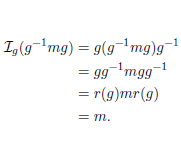Las nociones de centro, conmutador e isomorfismo interno para grupoides
Main Article Content
Keywords
Grupoide, subgrupoide normal, normalizador, centro, conmutador, isomorfismo interno
Resumen
En este artículo se introduce algunas propiedades algebraicas de los subgrupoides y subgrupoides normales. Definimos el normalizador de un subgrupoide amplio H de un grupoide G y mostramos que, como en el caso de grupos, este normalizador es el mayor subgrupoide amplio de G en el cual H es normal. Además, damos las definiciones de centro Z(G) y conmutador G' del grupoide G y probamos que los dos son subgrupoides normales. También damos las nociones de isomorfismo interno e isomorfismo parcial de G y mostramos que el grupoide I(G) dado por el conjunto de todos los isomorfismos internos de G es un subgrupoide normal de A(G), el conjunto de todos los isomorfismos parciales de G. Además, probamos que I(G) es isomorfo al grupoide cociente G/Z(G), lo cual extiende a grupoides un resultado bien conocido para grupos.
Descargas
Referencias
[1] H. Brandt, “Über eine verallgemeinerung des gruppenbegriffes,” Math. Ann, vol. 96, pp. 360–366, 1926.
[2] C. Ehresmann, OEuvres complètes et commentées, ser. Oeuvres complétes. Topologie algéBrique et géométrie différentielle, 1950, no. partes 1-2.
[3] R. Brown, “From groups to groupoids: a brief survey,” Bulletin of The London Mathematical Society - BULL LOND MATH SOC, vol. 19, pp. 113–134, 03 1987. https://doi.org/10.1112/blms/19.2.113
[4] A. Ibort and M. Rodríguez, “On the structure of finite groupoids and their representations,” Symmetry, vol. 11, p. 414, 03 2019. https://doi.org/10.3390/sym11030414
[5] G. Ivan, “Strong morphisms of groupoids,” Balk. J. Geom. Appl., vol. 1, no. 4, pp. 91–102, 1999. https://www.emis.de/journals/BJGA/v04n1/B04-1-IVAN.pdf
[6] G. Ivan, “Algebraic constructions of brandt groupoids,” pp. 69–90, 01 2002.
[7] S. Zakrzewski, “Quantum and classical pseudogroups. ii. differential and symplectic pseudogroups,” Comm. Math. Phys., vol. 134, no. 2, pp. 371–395, 1990. https://projecteuclid.org:443/euclid.cmp/1104201735
[8] P. Stachura, “Short and biased introduction to groupoids,” J. Knot Theor. Ramif., vol. 27, no. 7, pp. 1–13, 2018. https://arxiv.org/pdf/1311.3866.pdf
[9] M. Lawson, Inverse Semigroups: The Theory of Partial Symmetries. World Scientific, 1998. https://books.google.com.co/books?id=2805q4tFiCkC
[10] A. Paques and T. Tamusiunas, “The galois correspondence theorem for groupoid actions,” Journal of Algebra, vol. 509, pp. 105 – 123, 2018. https://doi.org/10.1016/j.jalgebra.2018.04.034
[11] J. Ávila, V. Marín, and H. Pinedo, “Isomorphism theorems for groupoids and some applications,” Int. J. Math. Math. Sci., vol. 2020, no. 3967368, pp. 1–10, 2020. https//doi.org/10.1155/2020/3967368
[12] B. Bainson and N. D. Gilbert, “The homology of principally directed ordered groupoids,” Homology Homotopy Appl., vol. 22, no. 1, pp. 1–9, 2019. https://arxiv.org/pdf/1704.03689v1.pdf
[13] H. Myrnouri and M. Amini, “Decomposable abelian groupoids,” Int. Math. Forum, vol. 5, no. 48, pp. 2371–2380, 2010.
[14] D. S. Dummit and R. M. Foote, Abstract Algebra, 3rd ed. New Delhi: Wiley, june 2003.

